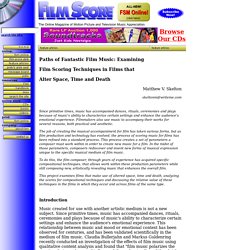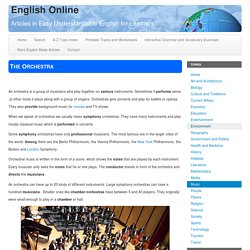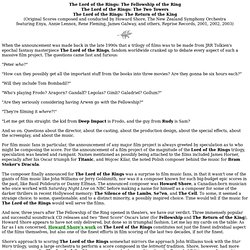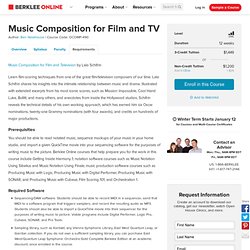

Examining Film Scoring Techniques in Films that Alter Space, Time and Death. Paths of Fantastic Film Music: Examining Film Scoring Techniques in Films that Alter Space, Time and Death Matthew V.

Skelton skeltonm@writeme.com Since primitive times, music has accompanied dances, rituals, ceremonies and plays because of music's ability to characterize certain settings and enhance the audience's emotional experience. The job of creating the musical accompaniment for film has taken various forms, but as film production and technology has evolved, the process of scoring music for films has been refined into a standard process. To do this, the film composer, through years of experience has acquired specific compositional techniques, that allows work within these production parameters while still composing new, artistically revealing music that enhances the overall film. Introduction Music created for use with another artistic medium is not a new subject. Film Scoring Basics Screening is a term for the actual viewing process. Formulating an Analysis Method Altered Space Synopsis. Tutorial_orchestral_template.pdf. Brass. The traditional line-up of the brasses is: Horns, Trumpets, Trombones, Tubas.

The numbers and combinations of these instruments vary greatly according to historical period, geographical location and, of course, composer choice. Probably the most common orchestral combination is: 4 horns 3 trumpets 3 trombones 1 tuba but there are numerous variations on this, including massively expanded groupings where required.
Horns are often used in combination with woodwind, and generally have a weaker sound than the other brass. Use the links on the left to sample various brass scorings from the Philharmonia's recorded archive. Solos and groups: Horns Back to top Trumpets Trombones Tubas Back to top Other combinations and tuttis: Back to top. The Guide To Orchestration. Part II: Panning And Melody. The Guide To Orchestration. Part I: Introduction Info And How To Start. Parts of a Symphonic Orchestra. An orchestra is a group of musicians who play together on various instruments.

Sometimes it performs alone ,at other times it plays along with a group of singers. Orchestras give concerts and play for ballets or operas. They also provide background music for movies and TV shows. When we speak of orchestras we usually mean symphony orchestras. They have many instruments and play mostly classical music which is performed in concerts. Some symphony orchestras have only professional musicians. Orchestral music is written in the form of a score, which shows the notes that are played by each instrument. An orchestra can have up to 20 kinds of different instruments. A Philharmonic Orchestra - Pedro Sánchez Sections of an Orchestra A modern orchestra consists of four sections or families of instruments.
VIENNA SYMPHONIC LIBRARY > VIENNA ACADEMY > Woodwinds > Flutes > Concert flute > SOUND COMBINATIONS. Vaious Artists, The Lord of the Rings soundtracks. When the announcement was made back in the late 1990s that a trilogy of films was to be made from JRR Tolkien's epochal fantasy masterpiece The Lord of the Rings, fandom worldwide cranked up to debate every aspect of such a massive film project.

The questions came fast and furious: "Peter who? " "How can they possibly get all the important stuff from the books into three movies? Are they gonna be six hours each? " "Will they include Tom Bombadil? " "Who's playing Frodo? "Are they seriously considering having Arwen go with the Fellowship? " "They're filming it where?! " "Let me get this straight: the kid from Deep Impact is Frodo, and the guy from Rudy is Sam? And so on. Musical Themes in "The Lord of the Rings" By Eric Rawlins Much has been said and written about Howard Shore's use of the Wagnerian leitmotif idea in his score for "The Lord of the Rings.

" Briefly, the idea is that the composer represents the important elements of the story — characters, objects, ideas — as musical themes or motives (leitmotif = "leading motive") in the score, and then uses these themes to expand and comment on the developing action. Note on The Hobbit: Several people have written me to ask if I intend to expand this site to include The Hobbit. I do not. Movie composers have been doing something like this, of course, ever since the invention of the talkies. Why has it never been done before now?
And I'll go ahead and say it now: This is the greatest movie score ever written. Emotional Soundtracks. Epic, Inspirational Soundtracks. Epic, Inspirational Soundtracks. Most Emotional Movie Soundtracks. Music Composition for Film and TV Course. Learn to write music in the style of big budget Hollywood films and TV programs.

Music Composition for Film and TV begins with an overview of important considerations for composing for film and TV, including how to balance music and dialogue, how to influence the audiences emotional response, and how to create music that elicits a location or time period. Each week, the course will focus on a different genre of music for film and TV - themes such as romance, sadness/sorrow, chase, heroic action, action adventure, horror, suspense, magic, fantasy, and comedy. 10 Best Dramatic Movie Scores. Basic Orchestration Guide.